Pacific Grove, CA
by Adam Clayman

The expression ‘the finest meeting of land and sea’ is echoed in this view from the 12th tee at Pacific Grove.
Just the thought of golfing along one of the worlds many coastlines, is enough to put a special glimmer, into any golfer’s eye. For those who long for their first, or subsequent, dose of the Monterey peninsula, a visit to Pacific Grove Municipal Golf Links, is as close to feeling ‘elite’ as many may likely get. Of those fortunate to frequent many of the coastal courses all over the world, few are as blessed as those that get to tee-it-up at Pacific Grove, frequently.
Nothing flashy, nothing over-the-top, just a billion dollar view accentuated with solid fun public golf, played in two-distinct styles, on terrains just as dissimilar. The two nines, built 28 years apart, are equally compelling, thoughtful, and always enjoyable for the purist.
The first nine built, was in a Parkland style(1932). The second nine is in dunesland (1960). Pacific Grove (PG) is the only golf course on the Monterey peninsula with both Bay and Ocean views.
The course is a perfect fit, amongst it’s bigger name neighbors, so good, some believe it must have been ‘designed-in’.
The greens can rival some of the best, with a perfect variety of bold, and subtle slopes. Kikuyu Grass fairways, helps to add playing length, to this sub 6000 yarder.
The weather conditions can be as fickle as they are magnificiant. Often with Fog, rolling in and out, with only a hint from the wind, to tell you when, and from which direction. The golfer’s senses are constantly tested, throughout these 18 holes. There are even moments, at certain spots, where the golfer can actually feel like they are on the end of the world. The rythmic crashing of the surf, hypnotizes the brain, makes for easy transport to minds end.
I will attempt to introduce you to my former home course, and if my speculating is correct, once you’ve golfed there, you will feel it your home course, away from home, too.
History
As reported to this author, by a spry octagenarian, Clifton Harris, it was he and his friend, Lowell Todd, that had dragged sand up from the beach in their little red wagons. The two boys made themselves 5 little golf holes. In the early 1930’s these two boys inspired the community activism, that ultimately became the PG golf course. With collaboration from Samuel F.B. Morse, who sold the land to the city (for a mere 10k) with the only stipulations that it was to remain a greenbelt and to be used for the recreation of peninsula residents. A banker named Gates, arranged financing, which this author can only imagine was no small feat, at the depths of the Great Depression.
Those first five little sand holes, made by the youngsters, were built very near the site of the current 5th green and 6th tee. The sixth hole, was the original starter, ergo, the fifth was the closer, until 1960. At that time, one of Pebble Beach’s original architects, Jack Neville, was brought in to design the new nine, built in the dunes at the southern tip of the Monterey Bay. Also, in 1960 a new clubhouse was financed, with the help from some of the local golfer’s, using their houses, as collateral. At this writting, another new Clubhouse is being constructed. Many of those original Clubhouse backers are still golfing at PG.
The Card
#1, Par 3 154 yards: With the cemetary and O.B on the right, one’s own impermanance is a worthy pre-swing thought. For a right hander to block one’s shot here, puts you there. The cart path running up the right side, doesn’t make the shot any easier, but certainly more unpredictable, if struck. If the cemetary isn’t enough, the deep oval bunker left and long, starting mid-green, will test the golfer’s nerves, early in the round. A nasty, narly-looking, rounded sheep-shed of a scar. The green wraps in front of it, and to the right of this deep left bunker. Pin positions can be creatively accessed,if the golfer relies on some bounce, off the randomly dotted of varying size, subtle mounds. According to some personal accounts, there was a bunker,short front-right, removed long ago. Evidence of it’s exisitence is still there.
#2- Par 3 220 yards: Yes, back to back one-shotters to start, both with the Out of Bounds Cemetary, on the right. This uphill hole features a large, high-lipped, gapping, oval bunker left of the green, and, a massive centerline apartment building, long. All to a green, that will confound even the most familiar, while allowing a first timer the challenge of apparent simplicity. The deceptive severe slope, is from back to front, and from sides to middle. Just getting one’s first shot on the green, here, is an achievemnet. Rumor has it, there was an original bunker greenside right. The turf has evidence of something. There use to be a train, complete with tracks, that bisected the course, directly behind this green. The train serviced the quarry that is now Spanish Bay.
#3 Par 4 316 yards: Tree encroached and option filled? Yup. Here’s a rare chance to learn something about oneself. A slight dogleg left (all created by the trees) complete with Chocolate Drops, under the tree canopy, near the ridge line that use to hold the railroad tracks, left. This hole features O.B. right, and long. A large oval bunker, front left, and, another elongated one, long. A severly sloping green towards the Bay’s entrance, to the left, features a right greenside mound, that can be used effectively, to swing the ball left. The golfer chooses his poison on this short two shotter, laying-up with any club in the bag, or pulling driver, and gambling with recoveries fate.
#4 Par 4 265 yards: Straightaway, downhill, O.B. right, and long, and is very driveable. The two sectioned green is wide to the horizontal, but narrow to the vertical. A severe slope distinguishs the two sections on the green, which falls away and towards the Bay to the left. Beachsand bunkers, short right, as well as long, keeps even the best of shots, on the edge of unpredictable, until the ball completely stops. The kikuyu grass, is never more of a factor, than when approaching this green. A deft touch is needed when the grass is high and the green firm.
#5 Par 5 515 yards: This old closer requires a drive into the narrowing, straightening fairway, off a slight jog to the left, up a small hill. With trees on both sides, a local rule allows the errant ball to the right, to be brought back into the centerline of trees, that separates this hole with the next. Safety and pace are justification for the local rule, and believe you me, it is no break. The free drop always leaves the golfer with a difficult shot on a sidehill downhill lie. The green is long vertically, to the player, with just enough slope to make every putt treacherous.
#6 Par 5 530 yards: The course turns back in, at this point, and now almost everything breaks to the right. This #1 handicap hole is defined by the trees on the right, and OB up the entire left, and long. The drive is to a flattish section before a small climb, climaxing at about the 150 yard mark. Then it tumbles down the same hill the golfer needed to climb, on the previous holes drive. The trees on the right are ever-present, as one needs to clear most of them, or stay left, so they won’t influence the golfer’s approach shot. The green is the reason this hole is the #1 handicap. Severely sloping from the back to front and to the bay, right. Protected on both sides with deep bunkers. Recovery from above the hole, left of the green, is as slippery as one could ask for.
#7 Par 4 320 yards: An uphill tee shot to a narrow landing area, protected on the left by old Cypress trees, and on the right, by Eucalyptus, and OB. The Cypress trees really enjoy a good surlyn breakfast, and have only been known to spit-out balls, after wind speeds reach 50+ mph. The green requires knowledge of forethought, with it’s subtle looking, but severe, small sections. Missing one’s birdie putt here, is not uncommon. With fronting bunkers on both sides, a wedge in hand will cause you to be extremely accurate, if success is to be recorded on the scorecard.
#8 Par 4 425 yards: The sharpest dogleg (so far) right, up a subtle climb, will have the golfer changing his preferred line depending on wind conditions. Trees, all along the right, and more on the left, this hole is as difficult as it is, in simplicity of design. Many a rabbit legs, get won and lost, on this tough par 4. The green is less contoured than all the previous, but in it’s subtlety lies most of it’s greatness. A bunker guards the front left, for those who don’t wish to challenge the gathering O.B., right.
#9 Par 3 218 yards: Playing directly into the prevailing wind, this one shotter will test the best in the world on club selection.
This hole has had a facelift recently, receiving a new USGA spec green. The replaced green was a teeny tiny thing, raised up like a short table top, with a rectangualr shape. Arguably one of the hardest pars on the course, the new green tries to emmulate the remainder, but has that ‘hollywood’ feel to it, when compared to the old push-ups. This hole was originally a par 4, but in 1960, when the clubhouse was built, it changed to a one-shotter, using the last half of the original hole, for a parking lot. Don’t it always seem to go?
#10 Par 3 106 yards: Another simple looking hole, that after 1000 rounds, garners more respect than on one’s first attempt. A stiff south wind can cause the golfer to club down to a mid-iron. With a deceptively sloped green and back bunker looming. Bogie is often in play on this apparent luller.
#11 Par 4 276 yards: Turning directly towards the sea, a line of dunes paints the back drop for this short hole, and is the virgins first clue they are about to be treated to an unprecedented American golfing experience. A small oval false front green tests the golfers imagination and touch. Distance accuracy is nae better tested, anywhere.
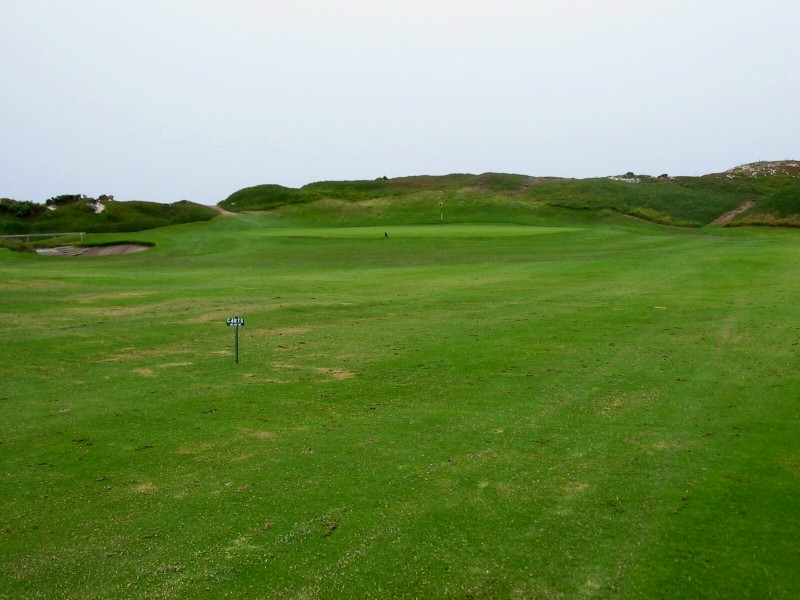
The 11th green is set at the base of the dunes.
#12 Par 5 525 yards: With nothing but the vastness of the Pacific Ocean in front of you, this dogleg right, short three shotter, required an in-course O.B. to be placed along the rightside, ending at the 100 yard mark. Words cannot do the walk up this hole justice, complete with wind pressed Cypress trees and the ever present Iceplant. Exposed to the elements, and the wilds, your scribe once watched a Killer Whale rejoice in a kill, with repeated jumps, is but one of this authors best memories. Humps, bumps, cants and contour, fill this hole, causing differing options of play from day to day. The drive can bite off as much dunesland as is comforatble, or play safe up the left. Either way, the likely third shot is from 60 yards and in, and is one of the most difficult, day-in day-out shots, on the entire course. Similar to the previous hole, the devilish false front, reduces the actual size of the green, and makes for exciting unpredictable golf.
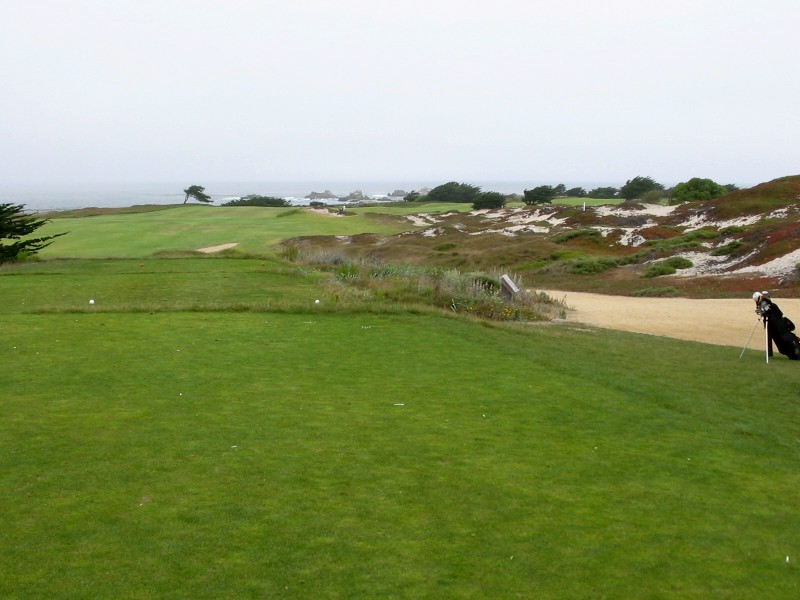
The 12th as seen from the tee as it sweeps to the right.
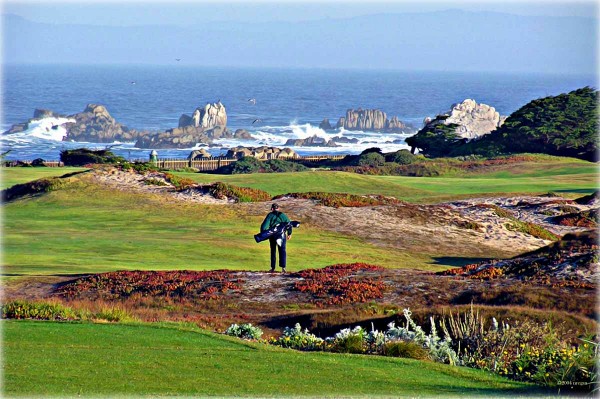
No chance this golfer wishes he was anywhere else other than walking down the 12th fairway at Pacific Grove.
#13 Par 4 307 yards: Standing on this raised teeing ground, the golfer is emmersed in a 270 degree water view. The remaning 90 degrees looks like a giant split fairway, around a massive dunesland, but, the area on the left is actually the next hole’s fairway, coming back. This hole features two mounds, one at the right edge of the centerline dunesland, directlly on the line of instinct to the green. The second mound, is front greenside left. The play is to drive the ball to the right, in-order to attempt to remove (or use) the greenside’s mound’s influence on approach. However, the front right of the green has a dipped area known as ‘valley of sin’, makes approaching from the right, a bit more problematic. The green sits in a bowl formed by dunes, covered in Iceplant, and, usually lounging Deer. The epitome of ‘never having to be more than that’ triskaidekaphobia is alive and well here, in one of it’s most simplistic forms.
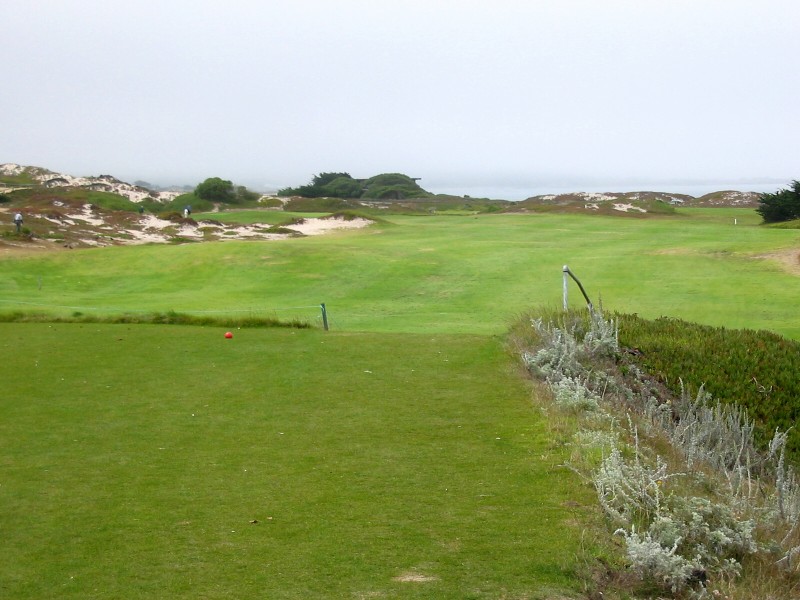
The view from the 13th tee.
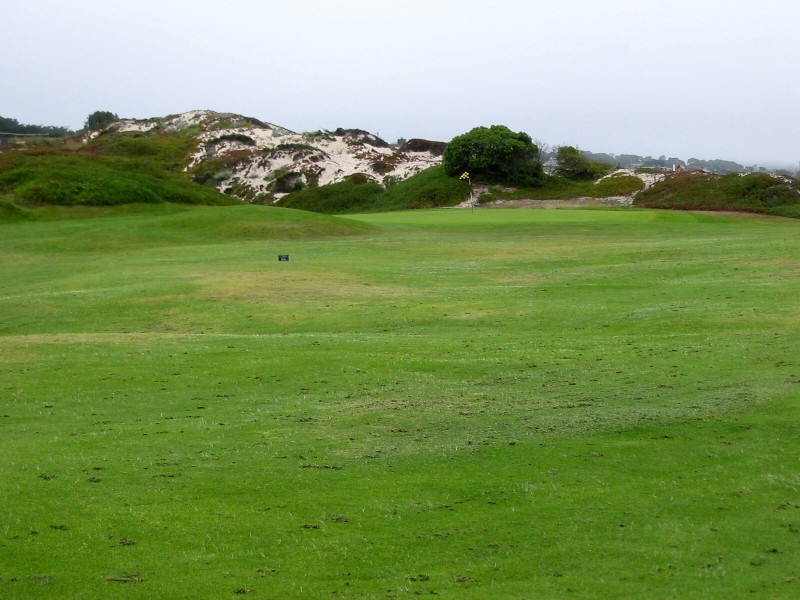
The deceivingly simple 13th green complex.
#14 Par 4 360 yards: Downhill, framed by dunes down the entire rightside, and partially on the left, this two shot hole is gunsighted with two mounds, 40 yards short of the deceptive green. These mounds allow for creative option filled shot making, especially in the winter months, when the Kikuyu lays down. Directly under the shadow of the 13th teeing ground, the 14th green is also completely surrounded by water, so that won’t help read this baby. Only experience, will help, and even that is sometimes fooled.
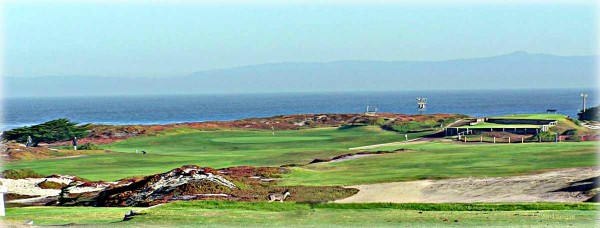
One view from the 14th tee…

…and another.
#15 Par 4 390 yards: Turning uphill, back towards the 14th tee, this hole has a slightly angled jog to the right, due to the placement of the teeing ground, partially blind from the duneline, now on the right. Almost pedestrian in look on approach, this hole rightly deserves it’s lowest handicap hole ranking, for the nine. The green, complete with a vertical spine, can cause some of the better players to howl about certain pin positions.
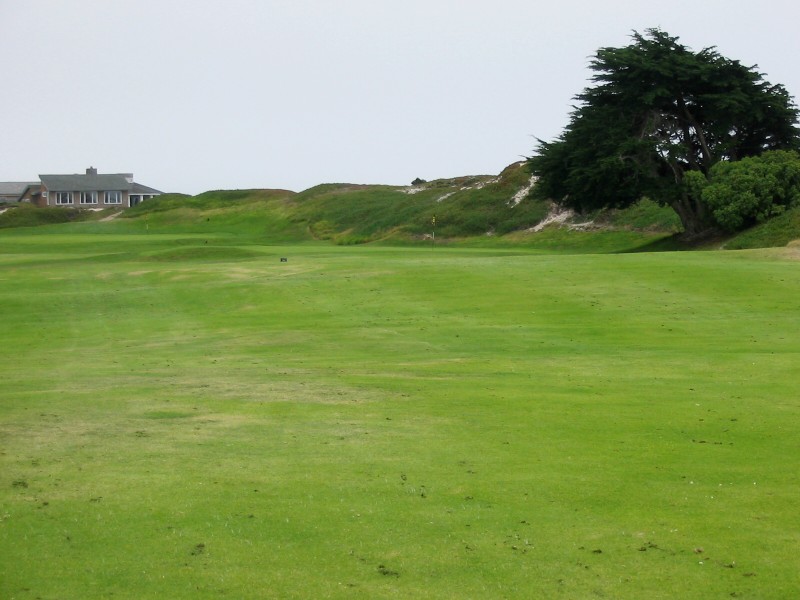
The uphill approach to the 15th.
#16 Par 4 375 yards:A wide open view of the preceeding 5 holes, The teeing ground lies directly adjacent to the Point Pinos Lighthouse. The hole tumbles down the hill, to what seems like a hundred yard wide fairway, towards a Cypress tree limb, that actually points the golfer to the target. As the golfer gets closer to the green, Crespi Pond becomes visible as the land slopes away revealing the only fresh water source, in the area. Recent alterations to this green complex were needed following some reckless act of senseless violence. With greenside bunkers that once stirred fear in the hearts and minds of even the most accomplished, the new Mrs. Grundys are sure to nursemaid the next generations of frequent golfers.

The open backdrop makes the approach to the 16th all the more tricky to judge.
#17 Par 3 156 yards:Playing over Crespi Pond this simple looking par 3 is all but. Complete with crashing waves and sometimes defeaning Harleys, the road adjacent to this hole, was instantly recognizable to your scribe, from watching decades of automobile commercials, that were shot right there.
#18 Par 4 300 yards: The walk up this hole is both sad and completely forgetable. Finishing with the weakest hole on the entire course, this uphill par 4, does however, have it’s magic and mysteries. Mostly caused by the drainage pattern of that tip of the peninsula, which runs directly under this hole, down towards Crespi Pond. The author just can’t help but speculate how great the closer could be, if the hill utilized as practice facility, were to be the final green site. It would rival any one of the finest closers, throughout the world.
The End







